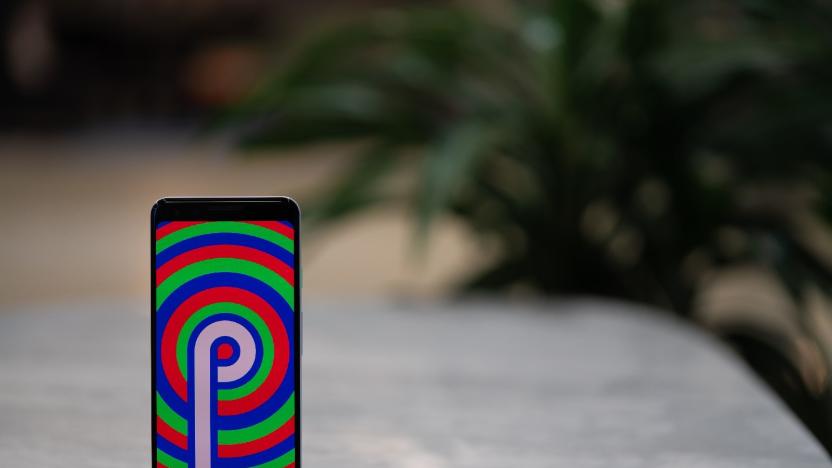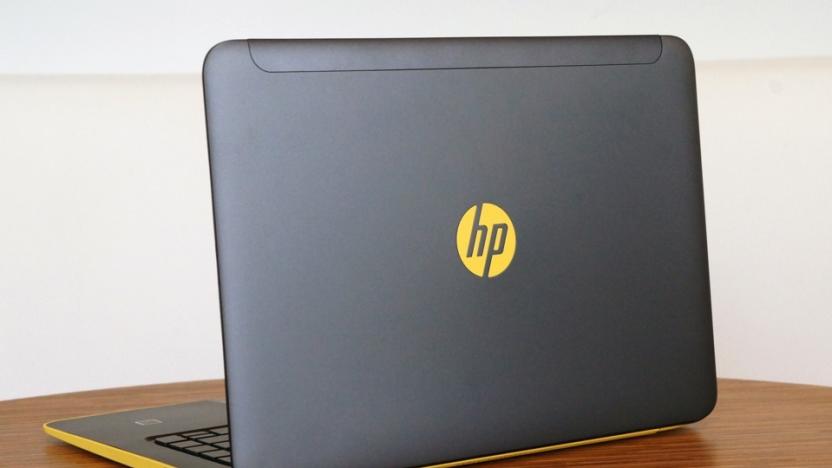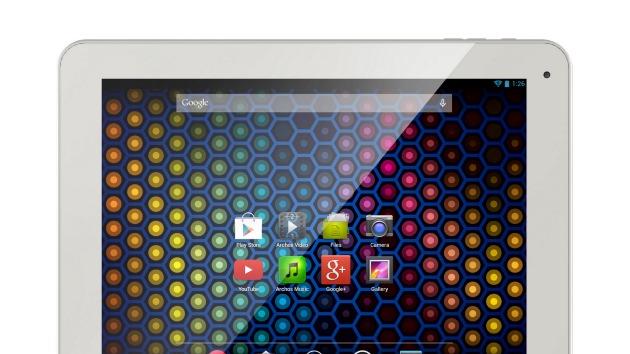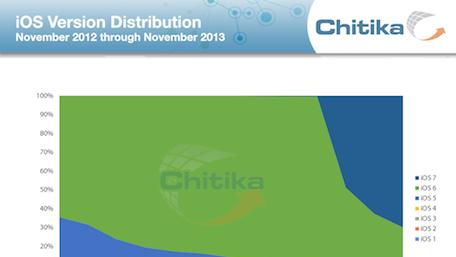jelly bean
Latest

Android Pie hits 10 percent adoption two months ahead of its ancestors
Google left people in the dark regarding Android Pie's adoption for more than half a year, but it's finally lifting the curtain -- and Pie is doing better than its predecessors. Updated stats supplied to VentureBeat show that 10.4 percent of active users were using Pie after eight months. That may not sound like much, but it took about 10 months each for Oreo and Nougat to reach the 10 percent milestone. Google's efforts to spur Pie's uptake appear to have paid off, even if it's not a night-and-day difference.

HP SlateBook 14 review: Android? On a laptop?
There's mounting evidence that HP, once the leading PC maker, does not know what it's doing. After announcing plans to cut up to 5 percent of its work force, the company is basically throwing stuff at the wall and seeing what sticks. Recent experiments include a luxury smartwatch, Chromebooks, a $199 Window notebook and now, a laptop running Android. Here's the sales pitch, and bear with me if this doesn't make sense: The SlateBook 14, according to HP, is for students and teens who already use Android on their mobile devices. In other words, they already own a Galaxy S5 or what have you, and they should have an Android laptop to match. The idea is that they might choose this over a Chromebook because it has more apps, and because it's more familiar. Ditto for Windows laptops -- except, you know, Windows actually has lots of apps too. Setting aside HP's flawed logic (they never said Windows users should stick to Windows Phone): Why would you pay $430 for a laptop running an OS that was primarily meant to be used with the fingers?

Archos' Neon tablets are even more budget-friendly than usual
Archos is summoning 2011 with the specs for its new Neon tablet line.The slate trio represents the low-end of Archos' lineup, and doesn't impress in the specs department. Falling under its Cobalt and Titanium series of tablets, all three tablets come sporting a quad-core A9 processor, 1GB of RAM, 8GB of onboard storage and microSD expansion. The Neon line includes the 9-inch Archos 90 Neon with 800 x 400 display, 9.7-inch 97 Neon with 1024 x 768 display, and the 10.1-inch 101 Neon with a 1024 x 600 display. The 9.7-inch tab comes with a 2-megapixel rear-facing cam, and all three come rocking forward-facing cams. Pricing and availability has yet to be announced, but we expect these three to come soon and under $200 apiece.

HTC confirms One X and X+ won't be upgraded to Android 4.3 or higher
It looks like Android 4.2.2 will be the end of the upgrade roadmap for the HTC One X and X+, two of the company's primary flagship phones in 2012. The phone maker tweeted out -- and later confirmed to the press -- that neither handset will be upgraded to Android 4.3 or anything newer. As frustrating as this announcement is, we don't consider ourselves shocked: the original One X launched nearly two years ago, and we speculate that the 15-month-old X+'s Tegra 3 processor may have been the reason for its fate. Take a look at HTC's official statement below. We can confirm that the HTC One X and One X+ will not receive further Android OS updates beyond Android 4.2.2 with Sense 5. We realize this news will be met with disappointment by some, but our customers should feel confident that we have designed both devices to be optimized with our amazing camera and audio experiences.

It's official: iOS 7 dominated 2013
We've been scanning the iOS version distribution data from Chitika since iOS 7 first launched in September, watching with amazement as the latest mobile operating system from Apple quickly pulled down almost 50 percent adoption within a month of release. Now Chitika has released findings for the end of 2013, showing that iOS 7 is now installed on close to 70 percent of all iOS devices, and that iOS 7 and iOS 6 combined account for about 90 percent of all North American iOS traffic. By comparison -- and we always love to point out the Android OS fragmentation issue when we can -- the latest two versions of Android (KitKat and Jelly Bean) account for a little more than 55 percent of its installed base now. The absolute latest version of Android, version 4.4 KitKat? It's only grabbing 1.1 percent of the total for Android as of December 2. Breaking down the numbers even further, it appears that a greater percentage of iPhones have made the iOS 7 plunge than iPads. For all iPhones, 74.1 percent are running iOS 7, with 22.4 percent operating on iOS 6. The numbers for iPads are lower, with iOS 7 achieving a 63.8 percent adoption rate and iOS 6 close behind at 24.6 percent. Chitika postulates that "the lower adoption rate of iOS 7 is likely at least partially due to features like AirDrop not coming to the iPad 2 or 3, minimizing the incentive for users of those devices to upgrade."

Samsung begins rolling out Android 4.3 update for Galaxy S III
While its promise to roll out Android 4.3 Jelly Bean to Galaxy S III owners by the end of October may have lapsed, Samsung isn't making users wait too long to get their hands on its latest update. Starting today, the Korean company has begun issuing over-the-air updates for its older flagship, adding compatibility with its Galaxy Gear smartwatch, speed improvements, a new lockscreen and actionable notifications. In fact, many new features mirror those found in the Android 4.3 build for the Galaxy S 4, which include an updated UI, voice controls and new screen modes. The update is already reaching devices in Ireland, with further countries set to follow once regional carriers give it the green light. Once that's complete, Samsung will have the small task of deciding which of its devices will get an upgrade to Google's latest OS treat.

LG Google TV update drops Flash but delivers more Play Store apps
Owners of LG Google TVs having been waiting on this Android 4.2.2 update for a good while. Not only does it bring relief from the sickly sweetness of Honeycomb, with no ROM hackery required, but it also adds NDK support, allowing more apps and games to run on the big screen and to be controlled by the Magic Remote (see the video below for more). One downside is that update switches out the original desktop-style Chrome browser with the Android version instead, which won't do much good for Flash-based content, but the browser does gain better HTML5 support and a new Vudu app as compensation. According to Android Police, the refresh has reached some GS6400 users already and is expected to roll out to other models over the coming days.

LG G Pad 8.3 revealed ahead of IFA, rolls out globally in Q4
Following up on its initial tease from earlier this week, LG has officially revealed the G Pad 8.3 ahead of IFA. The slate's positioned as the next step from its G2 smartphone, and the company claims it's the first eight-inch tablet with a 1920 x 1200 WUXGA (Widescreen Ultra Extended Graphics Array) full HD screen. The device features a 4,600mAh battery, and runs Jelly Bean 4.2.2 atop a 1.7 GHz quad-core Snapdragon 600 processor aided by 2GB of RAM. Despite all that, it's just 8.33m thick and weighs 338 grams. Software enhancements include QPair and QSlide -- the former lets you receive messages and calls from JB-equipped Android phones on the G Pad itself, while the latter allows for three apps to run on-screen at once. What's more, with KnockOn you simply tap the screen twice to wake it up. The G Pad 8.3 will be available globally beginning in Q4 in your choice of black or white with 16 GB of storage. No word on pricing just yet, but expect a hands-on once we catch it on the show floor.

Android 4.3 supports TRIM, improves performance on Nexus devices
It's no secret that many Android phones and tablets show a decrease in performance over time. Nexus devices are not immune -- it's particularly noticeable with the original Nexus 7. Our friend Brian Klug over at AnandTech discovered an interesting tidbit while testing the new and improved Nexus 7: Android 4.3 supports TRIM. What this means is that Google's mobile OS can now instruct the flash storage controller when to collect / recycle unused data pages / blocks. The net result is that devices running Android 4.3 will no longer become sluggish with time -- in fact, existing Nexus handsets and tablets will see performance improve after the update. It also looks like Jelly Bean invokes TRIM maintenance once within a 24-hour window (after one hour of inactivity), and only if the battery is 80% full (30% when charging). Follow the source link below for all the details.

Android 4.3 source code reveals support for 4K resolution
We've seen Android run on anything from low-resolution smartwatches to high-PPI phones and tablets, including the new 1920 x 1200-pixel Nexus 7 Google launched earlier this week. To make this possible, the mobile OS supports a number of pixel densities for app content -- from 120PPI (LDPI / Low DPI) to 480PPI (XXHDPI / Extra Extra High DPI). Close examination of the Android 4.3 (Jelly Bean) source code reveals the addition of a 640PPI (XXXHDPI / Extra Extra Extra High DPI) pixel density, which -- according to the comments in the code -- is intended for 4K televisions. Does this mean we'll begin to see Android devices with 640PPI Ultra HD displays? Perhaps, but considering 480PPI is overkill on handsets, this is most likely designed to make image assets and fonts, such as the Google TV UI, readable on 4K screens when viewed from a distance.

Android 4.3 leaks for the Nexus 4, teases us one last time
Oh, Android 4.3, why must you tease us so? The new version of Jelly Bean's been making cameos all over the place for a couple months now, so it was only a matter of time until we'd see a build available for download. A working TWRP backup of Android 4.3 just popped up on XDA Developers thanks to Google+ user Jeff Williams, who recently purchased a Nexus 4 running the new version of Jelly Bean. Some industrious folks were then able to extract a system dump from Jeff's phone (minus radio and bootloader, according to Android Police) and confirm that the build (JWR66N) is legitimate. Our friend Paul O'Brien over at MoDaCo is currently testing the TWRP backup. We'll keep you updated as we find out more, but one thing's abundantly clear: it won't be long before Android 4.3 becomes official.

Samsung Galaxy S 4 Google Play edition: what's different?
Several days ago we received a Samsung Galaxy S 4 Google Play edition to play with and shared our first impressions. This week we take a closer look at what's different between this handset and its TouchWiz-equipped cousins by scrutinizing the benchmarks, battery life and camera performance. Samsung pleasantly surprised us at Google I/O when it announced a Galaxy S 4 running stock Android. HTC then joined the party with its own unskinned superphone, the One. This Galaxy S 4, which landed in the Play store on June 26th for $649 contract-free, is identical to T-Mobile's 16GB model and shares the same specs. So, what does stock Android bring to this flagship? How does it compare to the TouchWiz versions? Is anything left behind? Finally, is this Google Play edition worth the extra cash? Hit the break to find out. %Gallery-192351%

HTC One Google Play edition: what's different?
Last week we got our hands on the HTC One Google Play edition and shared our first impressions. Today we dig a little deeper into how this superphone differs from its Sense 5-equipped siblings, with a focus on benchmarks, battery life and camera performance. As you'll recall, Samsung introduced a Galaxy S 4 running stock Android at Google I/O and HTC quickly followed suit by announcing an unskinned version of its own flagship, the One. The handset, which went on sale in the Play store on June 26th for $599 unsubsidized, is based on AT&T's 32GB model and features identical specs. As such, it also comes with the same limitations. So, what's the HTC One like with stock Android? Is it better than the devices running Sense 5? What do you give up and, most importantly, is it worth spending the premium for this Google Play edition? Find out after the break.

HTC One Google Play edition hands-on (video)
Samsung might have pleasantly surprised us with a Galaxy S 4 running stock Android at Google I/O last month, but it wasn't long before HTC followed suit with its own announcement regarding the One. Officially known as the HTC One Google Play edition, the phone is now available in the Play store for $599 alongside the aforementioned Galaxy S 4. When it comes to specs, the handset is a dead ringer for AT&T's 32GB version and incorporates the same radios (with LTE support). It features Qualcomm's 1.7GHz quad-core Snapdragon 600 SoC with 2GB of RAM, a 4.7-inch 1080p Super LCD 3 display, an Ultrapixel camera (4MP) with OIS and flash and a sealed 2300mAh Li-polymer battery. We finally played with it yesterday and came away rather smitten. Read on for our first impressions and hands-on video after the break.

Samsung Galaxy S 4 Google Play edition hands-on (video)
It's probably not a huge stretch to say that Samsung's Galaxy S 4 running stock Android was the biggest surprise to come out of Google I/O last month. The handset -- officially called Samsung Galaxy S 4 Google Play edition -- is now on sale in the Play store for $649 alongside a special version of the HTC One. Spec-wise, the phone is identical to AT&T's 16GB model and supports the same bands (including LTE). It's powered by Qualcomm's 1.9GHz quad-core Snapdragon 600 processor with 2GB or RAM and features a 5-inch 1080p Super AMOLED display, 13-megapixel camera with flash, removable 2600mAh Li-ion battery and microSD expansion. While we briefly handled the phone at I/O, it wasn't until yesterday that we got to spend some quality time with it. Hit the break for our first impressions and hands-on video. %Gallery-192351%

LG Optimus L7 II Dual listed running Android 4.3?
While Android 4.3 never actually materialized at Google I/O last month, the latest version of Jelly Bean keeps popping up and making cameos all over. It most recently appeared in the specs for LG's Optimus L7 II Dual (that name's a handful, we know) on the company's website. The handset was running Android 4.1 when we played with it at Mobile World Congress and appears to have shipped with that OS version in some markets. Obviously, it's only a matter of time until Android 4.3 becomes official but we fully expect it to debut on Google's own Nexus 4 flagship before coming to any other device. In light of this, and considering the Optimus L7 II features a 4.3-inch screen, perhaps we're just looking at a typo? We've reached out to LG for clarification -- we'll keep you posted. Update: LG confirmed this is a typo. Move along -- nothing to see here.

Android 4.3 confirmed by a developer website as Google kicks off I/O 2013
We've still got about an hour and 20 minutes until the Google I/O keynote begins, but we're already starting to get hints of what's to come. The company just revealed, in an indirect sort of way, that the next-gen version of Android will be Android 4.3 (as opposed to, say, 5.0). The name popped up on one of Google's developer pages, which ended up being cached despite the fact that it wasn't live for very long. Unfortunately, that page didn't reveal much in the way of actual features, so it's unclear whether the jump from 4.2 to 4.3 will be a minor one. In any case, we'll find out in 78 minutes and counting.

AntTek's Quick Settings app brings the shortcut menu to users still waiting on Jelly Bean
Still waiting for that upgrade to Jelly Bean? So are most Android users, if that's any consolation. While you might not see Android 4.2 before Google moves on to the next letter in its OS alphabet, you can get Jelly Bean's Quick Settings feature via a new app from AntTek. Available via Google Play, the program is compatible with Android 2.1 or later (no rooting required). It's pretty straightforward: you get a customizable settings menu, with options such as direct calling and email along with shortcuts to apps. We downloaded the free app and spent a few minutes toying around -- it looks almost exactly like Quick Settings on Jelly Bean, and there are several controls for tweaking icon size, changing the theme and selecting what actions you'd like to display. We're not huge fans of the red drop-down panel that you swipe to bring up the app, but you can minimize its size and adjust its position on the top of the home screen. AntTek says a pro version, with additional functionality and an unlimited number of icons on the Quick Settings panel, will be available for €1.49. Hit up the source link below to download the app.

LG Optimus L5 II debuts in Brazil, international rollout to follow
If the diminutive Optimus L3II is too small for you, and the L7II too big, today's porridge could be just right: LG's Optimus L5II is now available. Following in the footsteps of L3II, this 4-inch dual-SIM smartphone will make its debut in Brazil, eventually trickling out to unspecified markets in Central / South America, Europe, Asia, Africa and the Middle East. The handset's 1Ghz processor and 512MB of RAM will be powering Jelly Bean of course (Android 4.1.2, specifically), layered in the latest LG UX specific tweaks: Quick Button and Safety Care. The launch of the L Series II's middle child rounds out the second generation lineup, leaving LG to focus on matching the previous generation's sales record. Looking for the official details? Read on for the full press release.

ZTE V81 tablet shows up in website ahead of MWC, touts 8-inch display and Jelly Bean
Not quite content with the release of its Grand S earlier this month, ZTE looks to be preparing a new tablet to go along with that aforementioned flagship handset. The V81 -- which will presumably make its official debut at this year's Mobile World Congress -- is, according to the company's own website, said to be boasting an 8-inch (1,024 X 768) display with a dual-core, 1.4GHz CPU (mum's the word on chipset specifics), 1GB RAM and 4GB of internal storage that can be expanded to up to 32GB via microSD. Speaking of which, other listed incisions include a full-size USB and HDMI, while a 3,700 mAh battery and Android Jelly Bean are also part of the relatively decent spec sheet. Naturally, pricing and availability details are still slim, but it shouldn't be too long before we learn more on that front -- in the meantime, there's a gallery filled with V81 press shots after the break for you to peruse over.










